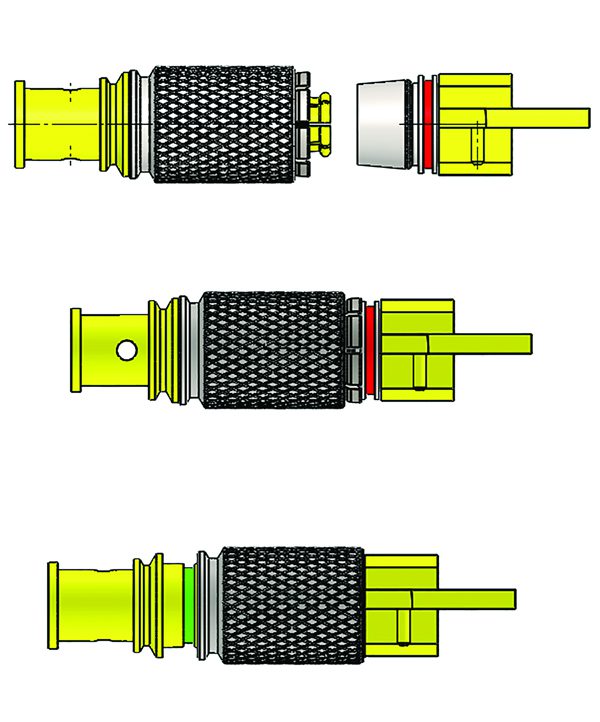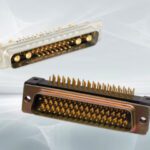New RF Interconnect Designs Address Shortcomings of the SMP Family of Connectors in Today’s Aerospace and Defense Applications
Innovative RF interconnect designs, address specific needs not fulfilled by standard designs such as the SMP connector.

The aerospace and defense industries count on dependable, durable RF systems for mission-critical electronics applications such as intelligence, surveillance, reconnaissance (ISR) systems, SATCOM and communications systems, electronic warfare (EW), missile guidance, and more. These systems must be highly reliable and offer consistently high performance—often in demanding, confined, and variable environments in the air, on the ground, and at sea.
The performance and reliability of any RF system is heavily determined by each of its hardware components and, especially, how they fit together. While some RF installations demand relatively standard products, others require custom solutions to meet unique requirements. For example, several innovative RF interconnect designs, including locking miniature connectors, locking miniature blind mate connectors, and multiport contacts, were created to address specific needs not fulfilled by standard designs such as the SMP connector.
The Shortcomings of SMP Connectors

For decades, the RF industry has used sub-miniature push-on connectors or SMPs. Initially sold in the late 1970s by Gilbert (now part of Corning) under the name GPOTM, these connectors were designed to scale down SubMiniature version A (SMA) connectors. While GPO products are specific trademarks of Corning, other manufacturers have incorporated a similar design to make compatible versions under the generic SMP terminology. As a result, it has become an industry-standard connector design.
SMPs are easy to install by pushing the connectors against each other and simply pulling them apart to disconnect. The connectors can mate without threading, eliminating the need for small wrenches and other tools. In addition, the SMP accommodates a small radial misalignment during mating. This would be unacceptable with threaded connectors.
However, while SMPs are still a valuable connector option for many designs, they pose problems as applications demand higher frequencies. One of the critical issues is shielding and electromagnetic interference (EMI). EMI is an undesirable phenomenon occurring when an external source causes a disturbance in the signal of interest. The SMP design uses wide slots to ease alignment and mating but results in a path for signal leakage. Similarly, the SMP’s design reduces its ability to function without affecting other equipment in the same environment. Called electromagnetic compatibility or EMC, the connector’s signal leakage issues often result in failed EMC tests. In short, the SMP’s lack of proper electrical bonding and shielding exposes the conductor’s signal to external influence.
Another central failure area in the design of SMPs makes them susceptible to ingress from salt water, fuel, and other contaminants. The lack of an environmental seal due to their mechanical openings makes SMPs prone to corrosion and failure. It can also cause increased VSWR and loss, resulting in poor performance. Devices using SMPs may also fail qualification because of an insufficient environmental seal.
A final problem arises with the use of SMPs in high-vibration applications. Their easy connect/ disconnect design makes the connectors susceptible to de-mating in this environment. Coupling nuts and third-turn fasteners are typically added to address the lack of attachment strength. However, these solutions often create a larger connector—which defeats the purpose of a miniature connector, particularly as electronic boxes get smaller and smaller.
What are Viable Alternatives to SMPs? RF Interconnect Alternatives
Locking Miniature Push-On and Locking Miniature Blind Mate Connectors

As technology advances, smaller-sized, O-ring sealed connector solutions have been created to offer better environmental protection, mechanical retention, and improved shielding. This includes a new generation of locking miniature push-on (TLMP) and locking miniature blind mate (TLMB) connectors. The TLMP/TLMB was created for areas where EMI may be an issue, such as a ship or aircraft, that require an environmentally sealed and shielded connector. The standard SMP may also disconnect in high-vibration environments such as a weapons launch, carrier landing, or any similar platform, making a locking miniature push-on connector the ideal choice.
The TLMP/TLMB connector maintains the SMP’s small form factor but adds improved shielding, environmental, and power capabilities, covering a range of frequencies from DC to 60 GHz. The connector’s slots are entirely covered by the mating part to prevent signal leakage. This enables the connectors to overcome performance issues from the SMP connector’s susceptibility to EMI and EMC interference as well as liquid and salt ingress. Their sealed, rugged design can withstand harsh conditions and severe environments better. At the same time, the high-power/high-voltage design overlaps the insulators, cutting off a direct path to the ground from the center conductor to the outer shield to enable higher-power or higher-voltage functionality.
The TLMP/TLMB connectors also feature a latching mechanism to improve mating retention, making them a better choice over options that use threaded bodies, including SMPs or similar designs created to overcome the problems of SMP connectors. In addition, a visual verification feature with green (locked) and red (unlocked) color coding assures connectors are fully mated and locked. Finally, the TLMB features an additional (to TLMP) outer sleeve to provide fully protected tines for true blind-mate applications.
Design offerings for TLMP/TLMB include edge and orthogonally launched to PCB/microstrip, MMIC, probe launch, and straight and right-angle connectors for a variety of coaxial cables. They are also available as 50-ohm terminations for plug or jack.
Similar in concept, new TLC and TLP connectors are available that are slightly larger for higher power handling. They are suitable for high continuous wave (CW) power applications with frequencies above 18 GHz.
Multiport Interconnect Systems

RF system manufacturers continually create advanced designs to accommodate extremely restricted space constraints and rising operating frequencies in aerospace and defense applications. The high-frequency RF interconnections within those systems are essential components. While many critical systems still operate in the 18 GHz range, newer ones are emerging that are required to work at 40 GHz.
Multiport contacts are being introduced, allowing equipment manufacturers to have one connection that accommodates all of these frequencies. This new contact type is compatible with existing multiport shells to maximize existing infrastructure while adding new assemblies to power high-frequency applications. Its unique construction makes this novel high-frequency contact excellent for use in the high-vibration, harsh environments typically found in military and avionics applications. Furthermore, it meets reduced size, weight, and power (SWaP) requirements.
Multiport interconnect systems can also address the lack of adequate electrical bonding, and shielding exposes the conductor’s signal to external influence, creating EMI and EMC issues in higher-frequency applications. They replace individual assemblies requiring multitudes of connectors with an alternate solution featuring a single connection port.
Furthermore, fitting the complex RF systems that power many critical functionalities on military and avionics applications into tight spaces can also allow unwanted coupling between RF transmission lines such as coaxial cables. Minimizing the distance between connectors and cables is necessary for the interconnect system to survive high vibration and other extreme environmental conditions. Multiport systems solve this problem with a smaller, modular connector assembly that integrates multiple coaxial contacts into a single housing for a higher interconnection density than individual coaxial connections. This reduces installation time, can ease system maintenance and testing, and increase reliability.
A vital part of this system is the multiport shell, a machined piece that allows the installation of multiple cables in one housing/interface. A multiport connector supplier should work closely with large prime contractors to develop plating materials with excellent salt fog resistance (2,000 hours) and sulfur dioxide resistance (668 hours). For example, leading multiport shells such as the M8 multiport connection system are constructed from lightweight aluminum and have advanced REACH/RoHS-compliant conductive platings tested to the most stringent corrosion resistance requirements.
New Solutions for New Challenges
Many standard connectors that have been around for a long time, such as SMPs, still work for what they were designed to do. However, newer, more challenging RF applications require a new generation of interconnect solutions for challenges such as high reliability, high vibration, and high density. Innovations in this area include locking miniature push-on, locking miniature blind mate, and multiport connectors.
When selecting RF cables and connectors, work with an experienced partner with engineers that can identify the application’s needs and design an optimized solution that is ultimately easier to use and creates better electrical, mechanical, and environmental performance. Choose a supplier that will work collaboratively as an extension of your design team. These systems are highly complex and do not use a standard solution, so it’s also vital that the RF supplier’s technical team asks questions and listens to understand the application’s unique needs.
Visit the Preferred Supplier page for Times Microwave to learn more about the company and its products.
Like this article? Check out our other How to Specify, Mil/Aero Market articles, and our 2022 and 2023 Article Archives.
Subscribe to our weekly e-newsletters, follow us on LinkedIn, Twitter, and Facebook, and check out our eBook archives for more applicable, expert-informed connectivity content.





